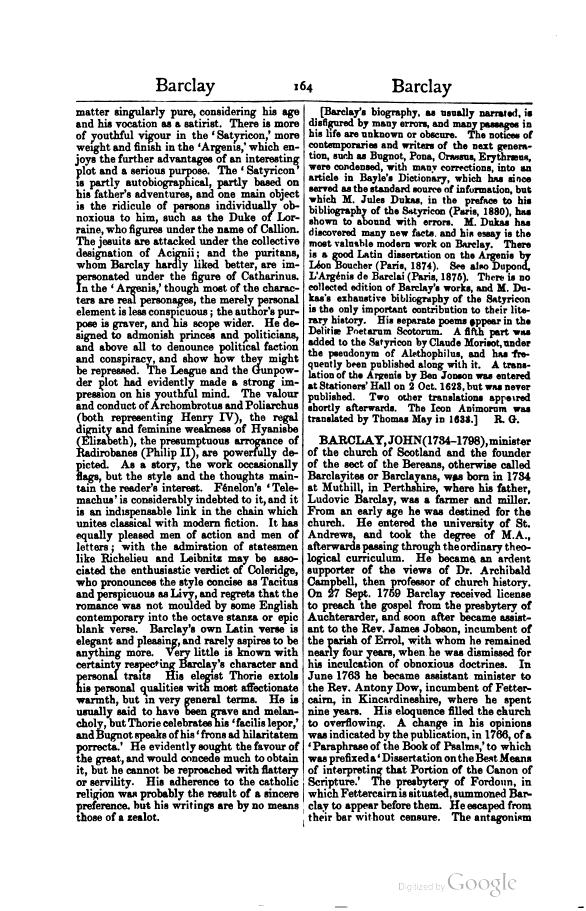matter singularly pure, considering his age and his vocation as a satirist. There is more of youthful vigour in the ‘Satyricon,’ more weight and finish in the ‘Argenis,’ which enjoys the further advantages of an interesting plot and a serious purpose. The ‘Satyricon’ is partly autobiographical, partly based on his father's adventures, and one main object is the ridicule of persons individually obnoxious to him, such as the Duke of Lorraine, who figures under the name of Callion. The jesuits are attacked under the collective designation of Acignii; and the puritans, whom Barclay hardly liked better, are impersonated under the figure of Catharinus. In the ‘Argenis,’ though most of the characters are real personages, the merely personal element is less conspicuous; the author's purpose is graver, and his scope wider. He designed to admonish princes and politicians, and above all to denounce political faction and conspiracy, and show how they might be repressed. The League and the Gunpowder plot had evidently made a strong impression on his youthful mind. The valour and conduct of Archombrotus and Poliarchus (both representing Henry IV), the regal dignity and feminine weakness of Hyanisbe (Elizabeth), the presumptuous arrogance of Radirobanes (Philip II), are powerfully depicted. As a story, the work occasionally flags, but the style and the thoughts maintain the reader's interest. Fénelon's ‘Telemachus’ is considerably indebted to it, and it is an indispensable link in the chain which unites classical with modern fiction. It has equally pleased men of action and men of letters; with the admiration of statesmen like Richelieu and Leibnitz may be associated the enthusiastic verdict of Coleridge, who pronounces the style concise as Tacitus and perspicuous as Livy, and regrets that the romance was not moulded by some English contemporary into the octave stanza or epic blank verse. Barclay's own Latin verse is elegant and pleasing, and rarely aspires to be anything more. Very little is known with certainty respecting Barclay's character and personal traits. His elegist Thorie extols his personal qualities with most affectionate warmth, but in very general terms. He is usually said to have been grave and melancholy, but Thorie celebrates his ‘facilis lepor,’ and Bugnot speaks of his ‘frons ad hilaritatem porrecta.’ He evidently sought the favour of the great, and would concede much to obtain it, but he cannot be reproached with flattery or servility. His adherence to the catholic religion was probably the result of a sincere preference, but his writings are by no means those of a zealot.
[Barclay's biography, as usually narrated, is disfigured by many errors, and many passages in his life are unknown or obscure. The notices of contemporaries and writers of the next generation, such as Bugnot, Pona, Crassus, Erythræus, were condensed, with many corrections, into an article in Bayle's Dictionary, which has since served as the standard source of information, but which M. Jules Dukas, in the preface to his bibliography of the Satyricon (Paris, 1880), has shown to abound with errors. M. Dukas has discovered many new facts, and his essay is the most valuable modern work on Barclay. There is a good Latin dissertation on the Argenis by Léon Boucher (Paris, 1874). See also Dupond, L'Argénis de Barclai (Paris, 1875). There is no collected edition of Barclay's works, and M. Dukas's exhaustive bibliography of the Satyricon is the only important contribution to their literary history. His separate poems appear in the Delitiæ Poetarum Scotorum. A fifth part was added to the Satyricon by Claude Morisot, under the pseudonym of Alethophilus, and has frequently been published along with it. A translation of the Argenis by Ben Jonson was entered at Stationers' Hall on 2 Oct. 1623, but was never published. Two other translations appeared shortly afterwards. The Icon Animorum was translated by Thomas May in 1633.]
BARCLAY, JOHN (1734–1798), minister of the church of Scotland and the founder of the sect of the Bereans, otherwise called Barclayites or Barclayans, was born in 1734 at Muthill, in Perthshire, where his father, Ludovic Barclay, was a farmer and miller. From an early age he was destined for the church. He entered the university of St. Andrews, and took the degree of M.A., afterwards passing through the ordinary theological curriculum. He became an ardent supporter of the views of Dr. Archibald Campbell, then professor of church history. On 27 Sept. 1759 Barclay received license to preach the gospel from the presbytery of Auchterarder, and soon after became assistant to the Rev. James Jobson, incumbent of the parish of Errol, with whom he remained nearly four years, when he was dismissed for his inculcation of obnoxious doctrines. In June 1763 he became assistant minister to the Rev. Antony Dow, incumbent of Fettercairn, in Kincardineshire, where he spent nine years. His eloquence filled the church to overflowing. A change in his opinions was indicated by the publication, in 1766, of a ‘Paraphrase of the Book of Psalms,’ to which was prefixed a ‘Dissertation on the Best Means of interpreting that Portion of the Canon of Scripture.’ The presbytery of Fordoun, in which Fettercairn is situated, summoned Barclay to appear before them. He escaped from their bar without censure. The antagonism
